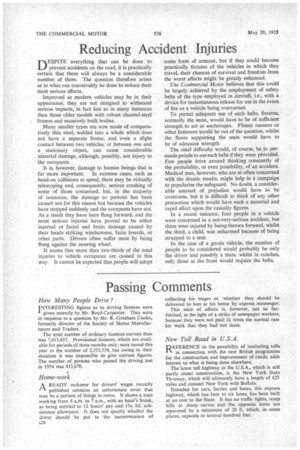Reducing Accident Injuries
Page 22

If you've noticed an error in this article please click here to report it so we can fix it.
DESPITE everything that can be done to prevent accidents on the road, it is practically certain that there will always be a considerable number of them. The question therefore arises as to what can conceivably be done lo reduce their most serious effects.
Improved as modern vehicles may be in their appearance, they are not designed, to withstand serious impacts, in fact less so in many instances than those older models with robust channel-steel frames and massively built bodies.
Many smaller types are now made of comparatively thin steel, welded into a whole which does not have a separate frame, and even a slight contact between two vehicles, or between one and a stationary object, can cause considerable Material damage, although, possibly, not injury to the occupants.
It is, however, damage to human beings that is far more important. In extreme cases, such as head-on collisions at speed, there may be virtually telescoping and, consequently, serious crushing of some of those concerned, but, in the majority of instances, the damage to persons has been caused not for this reason but because the vehicles have stopped suddenly and the occupants have not. As a result they have been flung forward, and the most serious injuries have proved to be either internal or facial and brain damage caused by their heads striking windscreens, facia boards, or other parts. Drivers often suffer most by being flung against the steering wheel.
It seems that more than two-thirds of the total injuries to vehicle occupants are caused in this way. It cannot be expected that people will adopt some form of armour, but if they could become practically fixtures of the vehicles in which they travel, their chances of survival and freedom from the worst effects might be greatly enhanced.
The Conimercial Motor believes that this could be largely achieved by the employment of safety belts of the type employed in aircraft, i.e., with a device for instantaneous release for use in the event of fire or a vehicle being overturned.
To permit adequate use of such belts, fixtures, normally the seats, would have to be of sufficient strength to act as anchorages. Flimsy runners or other fasteners would be out of the question, whilst the floors supporting the seats would have to be of adequate strength.
The chief difficulty would, of course, be to persuade people to use such belts if they were provided. Few people drive around thinking constantly of the probability, or even possibility, of an accident. Medical men, however, who are so often concerned with the drastic results, might help in a campaign to popularize the safeguard. No doubt, a considerable amount . of prejudice would have to be overcome, but it is difficult to think of any other precaution which would have such a material and rapid effect upon the casualty figures.
In a recent instance, four people in a vehicle were concerned in a not-very-serious accident, but three were injured by being-thrown forward, whilst the third, a child, was unharmed because of being strapped to a seat.
In the case of a goods vehicle, the number of people to be considered would probably be only the driver and possibly a mate, whilst in coaches, only those at the front would require the belts.




















































































